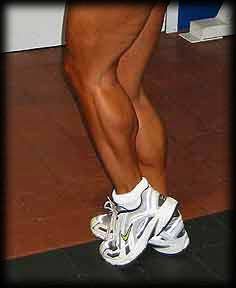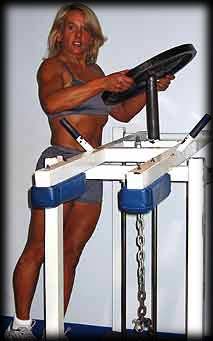 Men, boys, winners, losers; what creates the vast delta that separates the two categories? In bodybuilding the separation between winners and losers is often found in the neglected area of calf development. Mike Mentzer, Tom Platz and Arnold Schwarzenegger distinguished themselves as elite bodybuilders by developing symmetry in their legs with diamond shaped calves.
Men, boys, winners, losers; what creates the vast delta that separates the two categories? In bodybuilding the separation between winners and losers is often found in the neglected area of calf development. Mike Mentzer, Tom Platz and Arnold Schwarzenegger distinguished themselves as elite bodybuilders by developing symmetry in their legs with diamond shaped calves.
Many argue that genetics hold them back from developing enviable calves. Do not use genetics as an excuse to neglect this important area of overall development. Problems with poor calf development goes far beyond genetics. Lack of diamond shaped calves can be attributed to overtraining, improper form, treating calves as an afterthought in the overall training program, too little weight, too many reps and lack of mental intensity.
So, what's the calf challenge? Rather than focus on your lack of muscle below the knee, your biggest challenge should be how to get the machines to hold enough weight to keep up with your bulging, wide, diamond-shaped muscles.
Overtraining of calf muscles is an easy trap, one that catches even the most seasoned of bodybuilders. How many times have you heard this phrase? "Calf muscles are endurance muscles." By falling victim to the notion that endurance muscles need extra work, many then go and overwork this muscle group. Calf muscles like all other muscle groups need adequate recovery times. Work this muscle group, overload it to stimulate growth and then let it recover. Once per week in an intensive program, with acute mental focus, is all that is needed to build competitive level calves.
Improper form will not only create an environment where calves will not develop properly, it is also dangerous. Both experienced and inexperienced lifters will often perform calf exercises too quickly while also limiting the range of motion. This translates into lack of potential development. How often do you look over to the calf section of the gym and see bouncing? As you lower you heel towards the floor, there is a great deal of force placed on the Achilles tendon. It is critical that bouncing be avoided and control executed on the negative portion of the lift to avoid potential injury to the Achilles tendon.
Many experienced weightlifters will never reach their true potential in the area of calf development because they simply do not use enough weight. Mental toughness, focus, intensity and desire are needed to  overload the weight to the necessary degree for awesome development. It's easy to step up to a standing calf machine and move a pin in the stack, but taking it to the next level requires getting through the stack. And what degree of toughness is required to climb to the top of the machine to stack extra plates on top? Do you have that level of mental toughness? If you want those developed wide calf muscles, you're going to need that level of intensity.
overload the weight to the necessary degree for awesome development. It's easy to step up to a standing calf machine and move a pin in the stack, but taking it to the next level requires getting through the stack. And what degree of toughness is required to climb to the top of the machine to stack extra plates on top? Do you have that level of mental toughness? If you want those developed wide calf muscles, you're going to need that level of intensity.
Now, back to our challenge. How to stack enough weight on the machine? Piling those 45 pounders one on top of the other makes it nearly impossible to grip the plates, so be sure to stack 25 pound plates in-between the larger plates. Once you've maxed out the top pin for additional poundage using the 45s, it's time to move on to one-legged calf raises.
Developing bulging calves, requires the careful development of a training program that gives priority to this often neglected muscle group. Separate calves from quads and hamstrings on training days so they are no longer an afterthought. Be mentally prepared to challenge yourself to a new level of intensity and focus when training calves. This preparation assumes a high quality diet, adequate amounts of sleep and a week of recovery time between training sessions of this muscle group.
Begin a calf training session with four warm-up sets consisting of increasing weight levels and decreasing reps. In other words, your fourth warm-up set should consist of two or three reps that are viewed as weight acclimation reps rather than fatiguing in nature.
Be sure to work both the gastrocnemius (straight legged exercises) and the soleus (seated calf exercises), muscles in each training session. While much has been written regarding the direction of the toes when performing calf exercises, keep your toes facing straight ahead in order to achieve maximum overload. Always use a full range of motion with the heaviest weight you can handle. But, never sacrifice range of motion for a heavier load. Be sure to squeeze at the top of the contraction and fully extend and stretch at the bottom.
Due to the high intensity of this training protocol it is imperative to stretch between each set. Standing 2 1/2 to 3 feet from a wall, keep your legs straight, heels on the ground and lean into the wall. Hold the stretch for 20 seconds, then repeat standing further away from the wall. With each stretch, step further away from the wall while maintaining your heels on the ground.
Sample training programs:
Program A:
Standing Calf Raises 3 x 12-15, (following 4 warm-up sets)
Donkey Calf Raises 3 x 12-15
Seated Calf Raises 3 x 12-15
Program B:
Seated Calf Raises 3 x 8-12, (following 4 warm-up sets)
Calf Presses 3 x 8-12
Donkey Calf Raises 3 x 8-12
Program C:
Calf Presses 3 x 6-8 (following 4 warm-up sets)
Standing Calf Raises 3 x 6-8
Seated Calf Raises 3 x 6-8
Programs A, B and C should be rotated using one program each week. By varying the number of reps, periodization training is built into this calf training program. All sets are expected to be completed using a full range of motion, avoiding a bounce, control of the negative portion of the lift, and a squeeze at the top. All worksets require the mental intensity to be taken to failure to complete the planned rep range. Keep meticulous training journal notes and make weekly adjustments accordingly.
 Diane Fields is an ISSA Certified Fitness Trainer and in the process of completing a certification in Performance Nutrition. At 5 feet tall and 120 pounds, Ms. Fields is currently lifting 815 lbs on the standing calf machine, and is training to reach a goal of 1000 pounds by year end.
Diane Fields is an ISSA Certified Fitness Trainer and in the process of completing a certification in Performance Nutrition. At 5 feet tall and 120 pounds, Ms. Fields is currently lifting 815 lbs on the standing calf machine, and is training to reach a goal of 1000 pounds by year end.
In addition to personal training, Ms. Fields is a weight loss consultant and member of Legendary Fitness, LLC, a health and fitness company geared towards the special exercise and nutritional needs of babyboomers. You may contact Ms. Fields via email at fitnessgirl56@yahoo.com. Coming soon www.legendaryfitness.com offering online cardiovascular, training, nutrition and supplementation programs, products and support.
Additional articles written by Ms. Fields may be viewed at the following websites, www.getbig.com, www.protraineronline.com and www.atozfitness.com.
